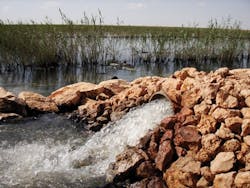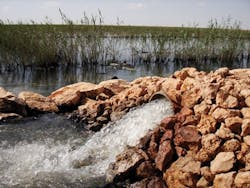UV System Offers Disinfection of CSO, Stormwater Flows
Chlorine has traditionally been used to provide disinfection of Combined Sewer Overflows due to its low cost. However, the growing awareness of the adverse environmental impacts associated with the byproducts of chlorination has led to increasingly restrictive chlorine residual requirements. A proven alternative disinfectant is the application of Ultraviolet (UV) disinfection for stormwater overflows.
UV disinfection technology has been used successfully in low UV transmittance (UVT) applications through proper UV reactor design and validation. The TrojanUV4000Plus™ system from Trojan Technologies has been tested, installed and is operating in a number of low UVT applications. The system has several design features that enable effective disinfection for challenging waters.
Effluent flows by gravity through the system’s fully submerged, tubular reactor, where it is exposed to high concentrations of UV light generated by medium pressure (MP) high intensity lamps. The contoured reactor walls ensure stringent control of the water layer around the lamps for consistent disinfection regardless of flow rate or water level.
UV modules house the lamps, quartz sleeves and cleaning system and pivot into the reactor opening at upstream and downstream ends. Lamps are placed in a staggered array, spaced evenly apart and optimized to balance the tradeoffs between head loss generated and mixing induced. After extensive computational fluid dynamics (CFD) modeling and field testing, vortex mixers were successfully incorporated in the module design to optimize performance at lower UVTs. The vortex mixers are mounted on the quartz sleeves, and increase flow turbulence and mixing around the lamps.
An important consideration in the operation of a low %T UV system is the ability to respond to varying water quality conditions. Over the course of a storm, water quality can vary significantly and the UV system must respond accordingly to ensure full treatment performance and to optimize power and lamp use.
Key monitoring equipment includes UV intensity sensors to measure lamp output, flow meters and on-line UV Transmission monitoring to track water quality throughout a storm event. As operating conditions and water quality fluctuates, the system controller automatically and continuously calculates operational power settings to achieve the required UV lamp output and ensure adequate disinfection.
Another design challenge equally critical to proper performance and long-term operation is quartz sleeve fouling rates and fouling removal. Due to low UVT, higher solids and in some cases the type of coagulants used, the rate and degree of fouling on the quartz sleeves can be accelerated in low UVT applications. Fouling must be removed to maximize the UV light transfer to the water.
The Trojan system uses an automatic cleaning mechanism that provides both mechanical (wipe-action) and chemical (dissolve-action) to remove fouling, optimize UV light delivery and reduce operator maintenance.
Case Study
It is estimated that over one billion gallons per day of stormwater and/or very low quality wastewater is currently being treated with UV disinfection at facilities in North America, Europe, Australia and Asia. Prior to selecting UV technology, several of these municipalities underwent a comprehensive bench scale and/or full scale field testing project to confirm UV’s effectiveness on their challenging effluent.
One particular municipality that evaluated, tested and installed UV for CSO treatment is the Cog Moors Wastewater Treatment Works (WwTW) facility located near Cardiff, UK, in the Barry catchment (southwestern UK region). The region in South Wales served by the Cog Moors WwTW includes three popular beaches. To protect public health, the Environment Agency Wales introduced stringent consents and stormwater spill limits of only three per bathing season, posing a compliance challenge for the Cog Moors WwTW.
The plant is equipped with an activated sludge process for secondary treatment and uses storm tanks to capture and store the storm flows. The facility evaluated several options that would enable compliance with Bathing Water Directives (including the limit on spill events per season). Options included: provision of additional 25,000 m3 stormwater storage capacity and UV disinfection of 2,380 liters/second (54 mgd) storm flow with UVT down to 30%.
Three key evaluations led to the selection of UV disinfection technology. A cost analysis for CAPEX and OPEX provision of additional storm storage capacity was 2.3 times more costly than installation and intermittent operation of UV disinfection based on a 20-year Net Present Value comparison (Imtech Process, Ltd). Secondly, the carbon footprint was evaluated for both options. It was concluded that UV treatment generated approximately one tenth the amount of greenhouse gas emissions.
The largest contributing factor for the stormwater storage option was the embodied emissions of greenhouse gas due to the use of concrete for construction of the stormwater tanks. In comparison, UV had a smaller footprint, used a fraction of the concrete and power consumption was intermittent (during storm events only) making the UV option even more attractive in the sustainability evaluation.
Finally, a pilot study was conducted to confirm the effectiveness of UV disinfection for the Cog Moors CSO effluent. It was the first UV plant in the UK designed to treat storm flows. Since commissioning in 2009, the UV plant has operated successfully. Effluent quality monitoring has shown the plant meets the required bacteriological reductions, ensuring that local beaches were safe for the community.
WW
More WaterWorld Current Issue Articles
More WaterWorld Archives Issue Articles

